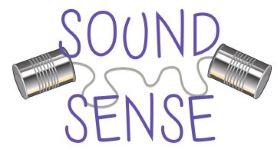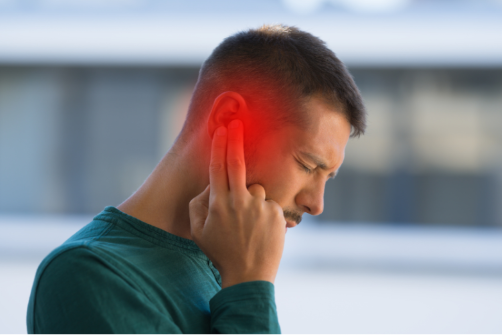
Tinnitus

Have you ever gone to a noisy concert and then come home to find your ears still ringing? Tinnitus, the perception of a phantom sound, is one of the most common hearing disorders in the world. Nearly 30,000,000 people in the United States experience tinnitus.
Although half of people with tinnitus report no noticeable hearing loss, tinnitus is often one of the first signs of hearing loss. Approximately one in five people with tinnitus find that this troublesome noise interferes with their daily lives, often creating difficulties with:
- Falling asleep or staying asleep
- Overall anxiety
- Maintaining attention to daily tasks
Hearing in noise, reverberation, or at a distance despite "normal" hearing
The causes of tinnitus can range greatly. Most commonly, tinnitus occurs with hearing loss resulting from damage to hair cells within the cochlea. Tinnitus is most often reported by people with a history of:
- Noise exposure (e.g., loud music, gunfire, etc.)
- Exposure to ototoxic medications (damaging to the ears) or chemicals
- Head Traumas and Traumatic Brain Injuries
- Genetic or familial hearing loss
- Certain illnesses which involve hearing loss or vertigo
- Growths such as tumors
Noise exposure is very common with soldiers and musicians. Veterans with a history of noise exposure from firearms report tinnitus more often than any other hearing disorder. Another very common, but less discussed, cause of the disorder is when medications or chemicals cause a toxic reaction in the ears, damaging portions of the cochlea. These substances can range from non-prescription and prescription medications such as aspirin and chemotherapy drugs such as cisplatin to toxic chemicals such as those used in making styrofoam. Traumatic brain injuries and head traumas also can result in symptoms of tinnitus as they can cause damage to the cochlea or portions of the brain related to hearing and auditory processing.
Of particular note to watch for are when tinnitus co-occurs with facial paralysis or taste/smell disturbance, or occurs in only one ear or a one-sided hearing loss is diagnosed as these symptoms are red-flags for potential brain involvement and may require an Auditory Brain Response (ABR), MRI, or CT scan. Further considerations for medical intervention may include roaring or rushing tinnitus, particularly in combination with sensations of pressure in the ear and feelings of vertigo, as these are a potential sign of Meniere's Disease. In addition, if your tinnitus seems to overlap with your heartbeat (e.g., pulsatile tinnitus), it can be a sign of a problem with your cardiovascular system and further evaluation of your carotid artery (and other veins/arteries in the neck and head) may be required to rule out the potential for risk of vascular blockages (e.g., stroke) or growths (e.g., glomus tumor).
Often people who have a history of familial hearing loss also find that the progressive hearing loss they have inherited brought along a secondary symptom of tinnitus. Certain systemic diseases, particularly those that affect the kidneys, liver, or the ears may also cause tinnitus. Some vascular diseases, like diabetes and heart disease, are also notorious for tinnitus.
Meniere's Disease, a disease thought to be autoimmune in origin, is often directly associated with tinnitus. This disorder which affects the inner ears, tends to cause some or all of the following symptoms:
- Roaring or Rushing Tinnitus
- Episodes of vertigo / dizziness
- Feelings of fullness / pressure in the ears
- Fluctuating low frequency (pitch) hearing loss
Tinnitus can take on all sorts of different sound qualities, from ringing to roaring to even the sound of an orchestra or seagulls. However, the most commonly reported tinnitus sounds tend to be ringing, hissing, rushing, or roaring. Certain sounds in tinnitus are often potentially associated with different causes. For example, hearing a non-rhythmic thump that can physically be felt in the ear may be a stapedial spasm. Many high-pitched ringing tinnitus sounds can often be attributed to either ototoxicity (medication and/or chemical cause of hair cell destruction in the cochlea) or to noise exposure causing damage to the higher frequency hair cells.
Once diagnostic evaluation has shown the tinnitus to be unrelated to any other illness, treatment can consist of a number of factors. According to a 2018 literature review of nearly 6,000 tinnitus treatment studies, it was concluded that tinnitus treatments using either one or more of the following:
- Masking Noise (white noise or pink noise)
- Amplification
- Counseling / Meditation / Medication
Masking noise, also known as white noise or pink noise, are sounds that can help reduce the perception of tinnitus. As one of the primary issues with tinnitus is the tendency for this sound to evoke a fight or flight / limbic response, a primary objective in working with patients who have tinnitus is to distract them from focusing directly on the tinnitus. It is important, however, that the amount of noise used in this distraction does not fully cover up all of the tinnitus as the brain needs to learn to acclimate to it through some level of experience and exposure.
Amplification via hearing aids often can help with providing that masking, either through the sounds present in ambient or environmental noise (and through rectifying any actual hearing loss with an appropriate prescription) or by adding in masking noise. Counseling and/or Meditation can also be very useful. Tinnitus Retraining Therapy is often performed in combination with masking noise and has been highly successful in more severe cases of tinnitus. Milder symptoms may do well with mindfulness meditation. Patients with high levels of anxiety may want to consider medically managing depression/anxiety as these can worsen symptoms of tinnitus and make it more difficult to remediate.
Hearing aid technology has come a long way since our grandparents. Current hearing aids can stream music and phone calls and can help people hear, even if their hearing is within normal by reducing background noise digitally and using directional microphones to hone in on a person's speech even in the noisiest environments. One of the features hearing aids have begun to incorporate is the ability to add in small amounts of masking noise to either low-gain amplification or conventional amplification in order to soothe tinnitus. In addition, the ability to stream music and other media from your phone can let you hear your favorite meditation or music discreetly.
If you'd like to discuss hearing aids for tinnitus, please reach out & we will set a meeting with an audiologist.